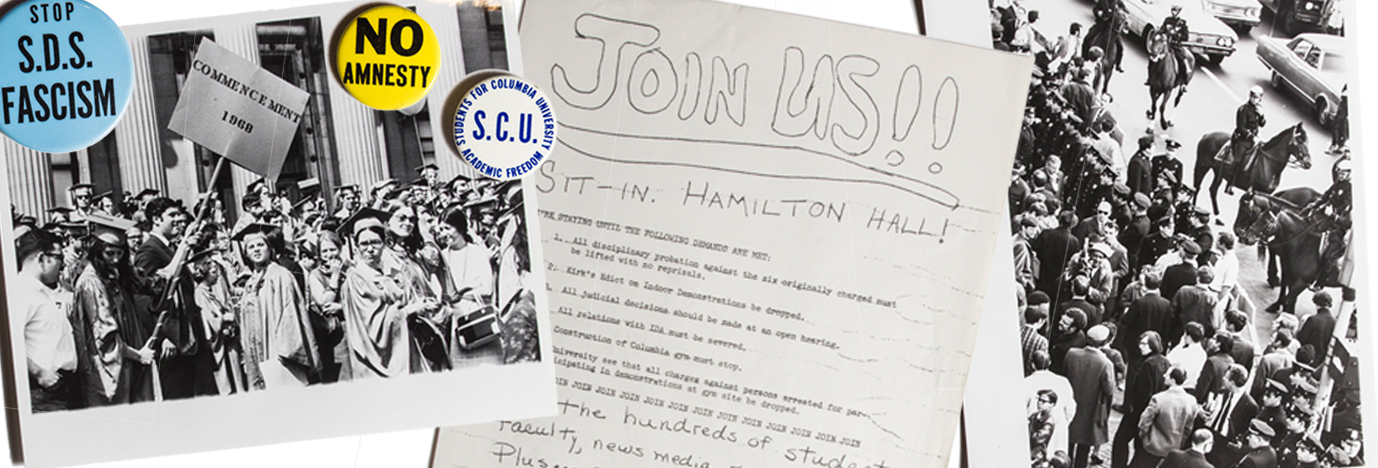Fifty years ago—on April 23, 1968—Barnard and Columbia students began a nonviolent occupation of Columbia campus buildings that lasted nearly a week. Rosalind Rosenberg, Professor Emerita of History, reflects on the protests that transformed Barnard women's lives and, together with student protests around the world, changed the political and social landscape. The full version of this article, which includes recollections of many Barnard alumnae, appeared in the Spring 2018 issue of Barnard Magazine on May 29.
Fifty years ago, in 1968, students around the world rose up: In France, Germany, Mexico, Japan; even in countries ruled by dictators, they picketed, occupied, and performed political theater in the streets. It was a trend, a movement, an earthquake. It was, however it was termed, a phenomenon.
In Morningside Heights, tensions had been brewing for years. Amidst the sexual revolution, Barnard students were frustrated about rules that restricted whom they could live with and who could visit them in residence halls. African American students and their allies were increasingly dissatisfied with University policies they saw as racist. The United States’ growing involvement in Vietnam and Columbia’s participation in military programs resulted in mounting opposition, led by groups including Students for a Democratic Society (SDS).

Growing Tensions
Barnard students were frustrated by the extent to which the College exerted control over their personal lives. Living off-campus with a boyfriend was strictly forbidden. But there was a loophole for students willing to lie on their housing forms: They could say they had live-in babysitting jobs, the one form of off-campus housing Barnard would accept for students living too far from home to commute. To live with her boyfriend, at least one student, Linda LeClair ’70, did just that.
At the same time, African American students were growing increasingly upset with persistent racism in American society broadly and in Morningside Heights in particular. Prior to the civil rights movement, their numbers had been small, not more than five per Barnard class. Now, an active admissions recruitment effort meant that there were about fifty black students at Barnard in the spring of 1968. That increase, paralleled at Columbia, enabled African Americans to form their own campus social life for the first time, including, in 1965, organizing the Students’ Afro-American Society (SAS).
Like earlier black students at Barnard and Columbia, members of SAS were active in the community—organizing rent strikes, condemning police brutality, and joining civil rights demonstrations. In 1968, they turned their attention to Columbia, siding with Harlem neighbors in opposing Columbia’s decision to build a private gym in Harlem’s public Morningside Park, to which faculty and Columbia students would be welcomed through the front door and neighborhood residents admitted through the back.
Members of SDS cared about the gym, too. But since 1965, the Columbia chapter, along with its national organization, had focused on Vietnam and resistance to the draft, which stopped exempting male graduate students in 1968. For three years, SDS and others at Columbia had mounted teach-ins about the war, organized busloads of students for trips to anti-war demonstrations, protested ROTC drills on South Field, defied University rules by blocking access to military and CIA recruiters inside Columbia buildings, and condemned the University’s ties to the Institute for Defense Analysis, which conducted classified research for the Pentagon. Columbia officials responded not by opening dialogue, as the protesters wanted, but by placing them on disciplinary probation.
Between January 30 and April 4, a series of events triggered the student revolt. The so-called Tet Offensive gave lie to American leaders’ claims that the U.S. was winning in Vietnam. Mark Rudd, a Columbia junior, was elected chairman of the Columbia SDS chapter on a platform entitled, “How to Get the SDS Moving Again and Screw the University All in One Fell Swoop.” Martin Luther King, Jr., was assassinated. And an article about cohabitation in The New York Times included an account of an unnamed Barnard student who, unbeknownst to College officials, was living off-campus with her boyfriend. Barnard’s dean of studies quickly identified the student as LeClair. The dean brought charges against her for lying on her housing form to Barnard’s judicial council. Obliged to enforce College rules but clearly on LeClair’s side, the council—including Barnard English instructor and pioneering feminist Kate Millett—ordered that LeClair be denied snack bar privileges and urged that the College policy be revised.
Occupations
By April 23, 1968, the leaders of SDS and SAS, along with a number of supporters, determined they needed to take action. Two Barnard students standing on a bench shouted, “The gym!” At that, the protesters headed to Morningside Park to take down the fence that cordoned off the construction site and reclaim the land for Harlem. When the police arrived and started to make arrests, leaders diverted the remaining protesters to Hamilton Hall, which they occupied.
The demonstrators’ goals began to diverge. SAS wanted the University to stop the gym’s construction; SDS wanted to stay in the building until Columbia severed its connection with the CIA and defense research. At around midnight, SAS requested that SDS leave. Some fifty white protesters headed to Low Library, where they took over President Grayson Kirk’s suite. Over the next four days, other protesters occupied Avery, Fayerweather, and Mathematics Halls before settling in for a siege. Judging from later arrest records, about a third of the protesters were women, roughly half of them from Barnard.
Most of the women were channeled into traditional gender roles: cooks and office assistants. Cathy Tashiro ’68 organized all the cooking in Mathematics Hall. Women did the same in the other buildings, but they harbored doubts. Nancy Biberman ’69 later saw a sign in Fayerweather that read: “To all women: You are in a liberated area. You are urged to reject the traditional role of housekeeper unless, of course, you feel this is the role that allows for creative expression. Speak up. Use your brains.”
Police Violence
On April 29, President Kirk called for New York City Tactical Police Force to clear the buildings. Police officers poured into the tunnels under the central campus and filled College Walk. They cut telephone and electrical lines and turned off water to the buildings. Early in the morning of April 30, they received the order to move in.
In Hamilton Hall, the first to be cleared, the arrests proceeded peacefully, thanks in part to African American political officials who helped open lines of communication between the students and police commissioner. Karla Spurlock-Evans ’71 later reflected that “the police that I saw were [all] black….[T]here was not a majority of black policemen in New York City at that time. So I think they had been identified and selected to come in to take this group of black students.”
In other buildings, the story was different. An all-white police force broke down doors and made their way through the furniture barricades. Then, to everyone’s shock, the police turned on the crowd of spectators. Some in the crowd were supporters; others hoped to prevent violence against the occupiers; many had come out of simple curiosity about what had been advertised across campus as a peace demonstration. The police attacked them all.
The police “riot,” as The Washington Post called the attack, had a dramatic effect. A protest that had initially attracted only a small minority of the University community now won the support of thousands of students and faculty who condemned the University for excessive force and failure to listen to students’ grievances. The Grateful Dead gave an impromptu concert in support. Students threw up picket lines around classroom buildings. Some professors moved their classes to their apartments or held them on the lawns outside buildings. It was, as Elizabeth Langer ’68 observed, a “transformative moment.”

